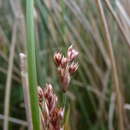More info for the term:
marshBlack rush is one of the dominant marsh species of the southern Atlantic
and Gulf coasts. In northwest Florida, it has been estimated that 60
percent of the salt marshes are covered with monospecific stands of this
species [
19]. In many situations, monospecific stands of smooth
cordgrass (Spartina alterniflora) form a seaward zone that borders black
rush. The boundary between these communities is usually distinct and
abrupt [
4,
19].
Black-rush-dominated communities have been separated into three
generalized categories based upon elevation and soil salinity influences
[
25]. The number of species associated with black rush tends to
increase as water salinity decreases [
4]. The three categories of black
rush marsh are presented below:
(1) Saline marsh, which experiences little dilution of tidal waters.
Associates include smooth cordgrass, saltmeadow cordgrass (S. patens),
giant cordgrass (S. cynosuroides), saltgrass (Distichlis spicata),
glasswort (Salicornia spp.), Olney threesquare (Scirpus americanus), and
saltmarsh bulrush (Scirpus robustus).
(2) Brackish marsh, where tidal waters are routinely diluted before
flooding the marsh. Associates include smooth cordgrass, giant
cordgrass, saltmeadow cordgrass, sealavender (Limonium caroliniana),
Olney threesquare, and common arrowhead (Sagittaria latifolia).
(3) Intermediate marsh, which is transitional between brackish and
freshwater marsh. Associates include common reed (Phragmites
australis), sawgrass (Cladium jamaicense), softstem bulrush (Scirpus
validus), and Virginia iris (Iris virginica).

